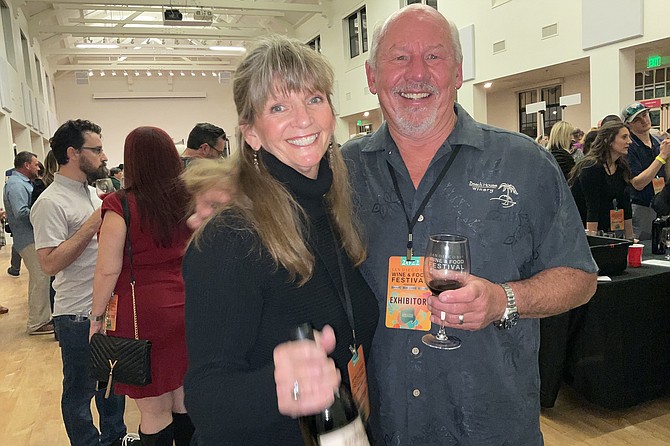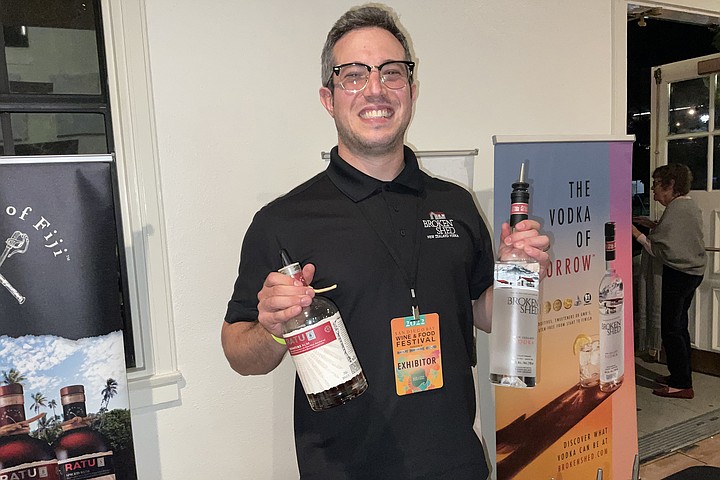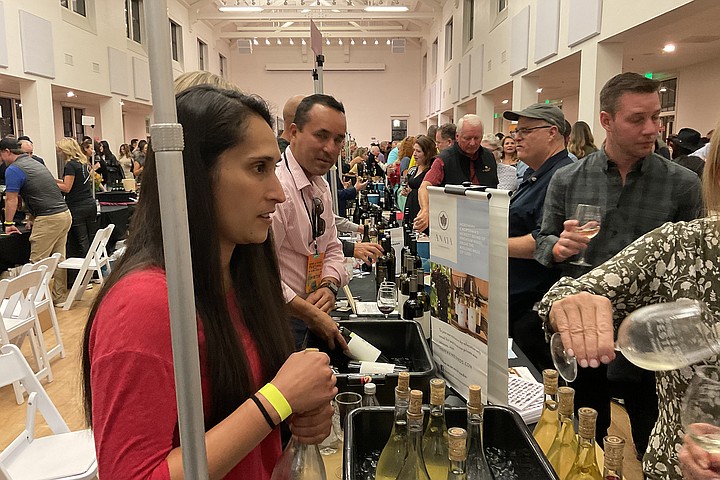 Facebook
Facebook
 X
X
 Instagram
Instagram
 TikTok
TikTok
 Youtube
Youtube

“Watch your step,” says the girl. “Watch your…oh dear. You okay sir?”
I brush off dust, drink, pride, and reply, “Yes of course.”
And it’s true — except for the pride part. I’m with a bunch of wine-happy people as we leave this “Grand Decant” soiree in Liberty Station, like a herd of polite buffalo stomping down the steps: heads-down, as if we’re trying to make it out onto the prairie. Except, now I look out over it, there’s something civilized, French about this campus, this restoration of the old, many-arched Naval Training campus. Especially here tonight, at Carruth Cellars. Hundreds of savvy wine drinkers have converged on this old barracks, and for $85 a head, have gone in to sample wines grown and bottled everywhere from Fallbrook to France.
“Watch your step, Ma’am.” This time, the gal says it to the next clump bulging out through the doors. Inside, people tried not to be pushy as they filled the intra-table rows, but still wanted to get their entry fee’s worth, and to fill their free “San Diego Bay Wine & Food Festival” goblets with “free” wine and then lean away from the table to take a sip. “Easy, darling. Long way down,” says one wife to her tall husband.

But it’s not just free wine that’s on offer. “This ‘Broken Shed’ vodka is from New Zealand,” a spokesman named Tom is saying at the very first table. “It’s specifically from the South Island, in Wanaka. It’s made of milk whey, and two sources of New Zealand water. There are no additives whatsoever; the milky whey — heh heh — provides a really nice creamy mouthful, so there’s no need to add sugar, like most brands do. The whole experience here is completely different from what you might be used to with vodka. ...And this is rum from Fiji. The Rum Co. of Fiji...Two kinds: ‘Bati’ means ‘warrior’ in Fijian, and ‘Ratu’ means ‘chief...”
Table after table boasts these loquacious salesmen and women with really interesting stuff to say about their products, mostly wines. Me, I’ve come looking for Mexican wines, probably Valle de Guadalupe wines, given that 80 percent of Mexican wines are produced right down there in that Baja valley. Except nobody I talk to knows of any being here tonight.
Bummer. I’ve been interested in Mexican wines ever since one night when I was in Tijuana, eating some Baja Med pizza at El Taller (“The Workshop”) restaurant, near “El Big,” the still-extant Big Boy coffee shop across Aqua Caliente from the old bullring. Got talking with this gent who said he was heading north to Chula Vista. “I have a vineyard here in Baja California,” he told me. “In the Guadalupe Valley. My problem is the Mexican government puts such a heavy tax on it that even I can’t afford to buy my own wines! Tonight I’m crossing the border so I can go buy a few cases of my own wine. Because it’s cheaper to buy Mexican wine in the United States than it is in Mexico.”

It turns out Mexican winemakers are victims of their own success. Back in the day — the 1600s — when Mexico was a Spanish colony, missions not only multiplied up and down the length of what was a single California, but initiated the first plantings in the entire New World of grape vines, to make sacramental wine (just as they imported palm trees to grow mainly for use on Palm Sunday ceremonies). Northern Baja seemed to have the more perfect climate for grapes. Vineyards expanded, and became such a success that the Padres started getting surpluses. Naturally, they sent that extra wine back to sell in the Motherland, Spain. Spanish wine growers felt so threatened that they petitioned the king to forbid all wine growing in the Mexican colony, and in 1701, Spanish King Charles II ordered all vines in the New World destroyed.
Mexican leaders proved little better. “Once Mexico gained its independence in 1821,” said my new friend at El Taller (who preferred not to have his name used), “the Revolution’s new leaders couldn’t resist imposing a 100 percent tax on all wines Mexico produced. That didn’t apply outside Mexico. Which is why I’m traveling out of my country to buy my own wine!”
Which could also explain why, still, according to the website Uncork Mexico, Mexicans only drink on average six glasses of wine per year. And most of those are women. Compare that to the U.S., where people drink three gallons of wine each in an average year, while the Portuguese down 17 gallons! Part of the reason for the contrast between the U.S. and Mexico? California imposes a total of about 8 percent tax on wine. The Mexican government currently imposes 42 percent.
But the main wines sluicing around tonight’s event are more famous: Napa Valley and Sonoma vino. Yes, there is a good scattering of San Diego vineyards represented, but many are small operations. “We’re just a mom and pop,” says Fallbrook’s Beach House Winery owner George Murray. He’s exhibiting along with his wife and co-owner, Kim Murray. “Kim and I don’t view other wineries as competition, I view this as a collaboration. We’re all helping each other to grow the industry. We want to create a destination area that includes us all.”
But you can’t help feel the irony. This brave new world is just happening now? In San Diego, where California wine began — hello! — in 1769, way before the gold-rush start-ups like Napa and Sonoma muscled in? Yet here’s our fair city, the mother-lode of California wine’s history, still knocking on the door of oenological respectability, wanting to be accepted. And one thing for sure, at this show anyway: Right here on the border, there are “No Mexican wines here.” This feels like some sort of travesty. Mexico, which gave birth to the first vineyard, Casa Madero, in 1597, and the missions including San Diego de Alacala, the granddaddies of Baja wine producers, is treated like a Johnny-come-lately, where growers are glad of any “competitors” to join them in the struggle for respectability against the giants from Napa and Sonoma. Kim and George Murray cheerfully exclaim “We band together!” But you’ll be hard put to find any San Diego wines in your local liquor store.


“Watch your step,” says the girl. “Watch your…oh dear. You okay sir?”
I brush off dust, drink, pride, and reply, “Yes of course.”
And it’s true — except for the pride part. I’m with a bunch of wine-happy people as we leave this “Grand Decant” soiree in Liberty Station, like a herd of polite buffalo stomping down the steps: heads-down, as if we’re trying to make it out onto the prairie. Except, now I look out over it, there’s something civilized, French about this campus, this restoration of the old, many-arched Naval Training campus. Especially here tonight, at Carruth Cellars. Hundreds of savvy wine drinkers have converged on this old barracks, and for $85 a head, have gone in to sample wines grown and bottled everywhere from Fallbrook to France.
“Watch your step, Ma’am.” This time, the gal says it to the next clump bulging out through the doors. Inside, people tried not to be pushy as they filled the intra-table rows, but still wanted to get their entry fee’s worth, and to fill their free “San Diego Bay Wine & Food Festival” goblets with “free” wine and then lean away from the table to take a sip. “Easy, darling. Long way down,” says one wife to her tall husband.

But it’s not just free wine that’s on offer. “This ‘Broken Shed’ vodka is from New Zealand,” a spokesman named Tom is saying at the very first table. “It’s specifically from the South Island, in Wanaka. It’s made of milk whey, and two sources of New Zealand water. There are no additives whatsoever; the milky whey — heh heh — provides a really nice creamy mouthful, so there’s no need to add sugar, like most brands do. The whole experience here is completely different from what you might be used to with vodka. ...And this is rum from Fiji. The Rum Co. of Fiji...Two kinds: ‘Bati’ means ‘warrior’ in Fijian, and ‘Ratu’ means ‘chief...”
Table after table boasts these loquacious salesmen and women with really interesting stuff to say about their products, mostly wines. Me, I’ve come looking for Mexican wines, probably Valle de Guadalupe wines, given that 80 percent of Mexican wines are produced right down there in that Baja valley. Except nobody I talk to knows of any being here tonight.
Bummer. I’ve been interested in Mexican wines ever since one night when I was in Tijuana, eating some Baja Med pizza at El Taller (“The Workshop”) restaurant, near “El Big,” the still-extant Big Boy coffee shop across Aqua Caliente from the old bullring. Got talking with this gent who said he was heading north to Chula Vista. “I have a vineyard here in Baja California,” he told me. “In the Guadalupe Valley. My problem is the Mexican government puts such a heavy tax on it that even I can’t afford to buy my own wines! Tonight I’m crossing the border so I can go buy a few cases of my own wine. Because it’s cheaper to buy Mexican wine in the United States than it is in Mexico.”

It turns out Mexican winemakers are victims of their own success. Back in the day — the 1600s — when Mexico was a Spanish colony, missions not only multiplied up and down the length of what was a single California, but initiated the first plantings in the entire New World of grape vines, to make sacramental wine (just as they imported palm trees to grow mainly for use on Palm Sunday ceremonies). Northern Baja seemed to have the more perfect climate for grapes. Vineyards expanded, and became such a success that the Padres started getting surpluses. Naturally, they sent that extra wine back to sell in the Motherland, Spain. Spanish wine growers felt so threatened that they petitioned the king to forbid all wine growing in the Mexican colony, and in 1701, Spanish King Charles II ordered all vines in the New World destroyed.
Mexican leaders proved little better. “Once Mexico gained its independence in 1821,” said my new friend at El Taller (who preferred not to have his name used), “the Revolution’s new leaders couldn’t resist imposing a 100 percent tax on all wines Mexico produced. That didn’t apply outside Mexico. Which is why I’m traveling out of my country to buy my own wine!”
Which could also explain why, still, according to the website Uncork Mexico, Mexicans only drink on average six glasses of wine per year. And most of those are women. Compare that to the U.S., where people drink three gallons of wine each in an average year, while the Portuguese down 17 gallons! Part of the reason for the contrast between the U.S. and Mexico? California imposes a total of about 8 percent tax on wine. The Mexican government currently imposes 42 percent.
But the main wines sluicing around tonight’s event are more famous: Napa Valley and Sonoma vino. Yes, there is a good scattering of San Diego vineyards represented, but many are small operations. “We’re just a mom and pop,” says Fallbrook’s Beach House Winery owner George Murray. He’s exhibiting along with his wife and co-owner, Kim Murray. “Kim and I don’t view other wineries as competition, I view this as a collaboration. We’re all helping each other to grow the industry. We want to create a destination area that includes us all.”
But you can’t help feel the irony. This brave new world is just happening now? In San Diego, where California wine began — hello! — in 1769, way before the gold-rush start-ups like Napa and Sonoma muscled in? Yet here’s our fair city, the mother-lode of California wine’s history, still knocking on the door of oenological respectability, wanting to be accepted. And one thing for sure, at this show anyway: Right here on the border, there are “No Mexican wines here.” This feels like some sort of travesty. Mexico, which gave birth to the first vineyard, Casa Madero, in 1597, and the missions including San Diego de Alacala, the granddaddies of Baja wine producers, is treated like a Johnny-come-lately, where growers are glad of any “competitors” to join them in the struggle for respectability against the giants from Napa and Sonoma. Kim and George Murray cheerfully exclaim “We band together!” But you’ll be hard put to find any San Diego wines in your local liquor store.
Comments